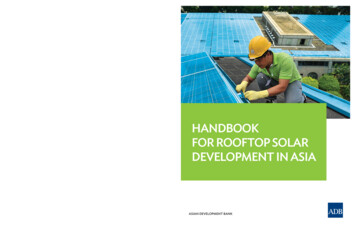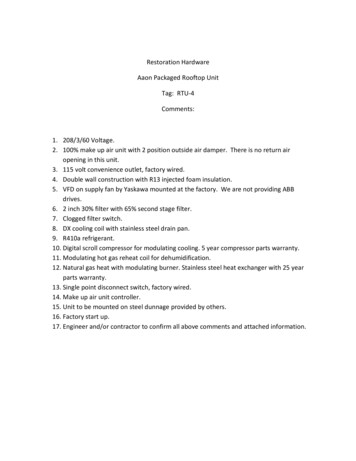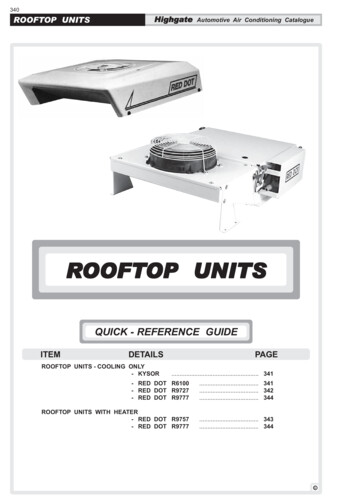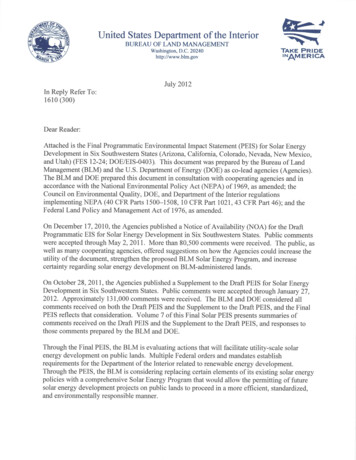
Transcription
Handbook for Rooftop Solar Development in AsiaDrawing on the Asian Development Bank’s experience installing the rooftop solar photovoltaic system atits headquarters, the Handbook for Rooftop Solar Development in Asia hopes to demystify the processof developing solar photovoltaic projects in urban areas. The handbook provides detailed descriptionsand guidance for all stages of development, including initial prefeasibility assessment, design, financing,procurement, and operations and maintenance. The Asian Development Bank hopes that entities lookingto take advantage of the benefits of solar photovoltaic systems would find the development process madetransparent and streamlined, and that this handbook would encourage the spread of solar photovoltaicsystems in cities throughout developing Asia and the Pacific.About the Asian Development BankHANDBOOK FOR ROOFTOP SOLAR DEVELOPMENT IN ASIAADB’s vision is an Asia and Pacific region free of poverty. Its mission is to help its developing membercountries reduce poverty and improve the quality of life of their people. Despite the region’s many successes,it remains home to approximately two-thirds of the world’s poor: 1.6 billion people who live on less than 2a day, with 733 million struggling on less than 1.25 a day. ADB is committed to reducing poverty throughinclusive economic growth, environmentally sustainable growth, and regional integration.Based in Manila, ADB is owned by 67 members, including 48 from the region. Its main instruments forhelping its developing member countries are policy dialogue, loans, equity investments, guarantees, grants,and technical assistance.HANDBOOKFOR ROOFTOP SOLARDEVELOPMENT IN ASIAISBN 978-92-9254-847-6ASIAN DEVELOPMENT BANK6 ADB Avenue, Mandaluyong City1550 Metro Manila, Philippineswww.adb.org9 789292548476ASIAN DEVELOPMENT BANK
ASIAN DEVELOPMENT BANK
2014 Asian Development BankAll rights reserved. Published in 2014.Printed in the Philippines.ISBN 978-92-9254-847-6 (Print), 978-92-9254-848-3 (e-ISBN)Publication Stock No. TIM146676Cataloging-In-Publication DataAsian Development Bank.Handbook for rooftop solar development in Asia.Mandaluyong City, Philippines: Asian Development Bank, 2014.1. Solar photovoltaic system.2. Energy.3. Clean energy.I. Asian Development Bank.The views expressed in this publication are those of the authors and do not necessarily reflect the views and policiesof the Asian Development Bank (ADB) or its Board of Governors or the governments they represent.ADB does not guarantee the accuracy of the data included in this publication and accepts no responsibility for anyconsequence of their use.By making any designation of or reference to a particular territory or geographic area, or by using the term “country”in this document, ADB does not intend to make any judgments as to the legal or other status of any territory or area.ADB encourages printing or copying information exclusively for personal and noncommercial use with properacknowledgment of ADB. Users are restricted from reselling, redistributing, or creating derivative works forcommercial purposes without the express, written consent of ADB.Note:In this publication, “ ” refers to US dollars.6 ADB Avenue, Mandaluyong City1550 Metro Manila, PhilippinesTel 63 2 632 4444Fax 63 2 636 2444www.adb.orgFor orders, please contact:Public Information CenterFax 63 2 636 2584adbpub@adb.org
ContentsList of Boxes, Figures, and Tables Preface vviiAcknowledgments viiiAbbreviations ixWeights and Measures xIntroduction xiPurpose of Handbook xiRooftop Solar: A High-Benefit Power Source xiCase Study: How ADB Transformed Its Rooftop xiiHandbook Contents xiiiChapter 1: Project Preparation 1.1 Site Assessment 1.2 Legal and Regulatory Frameworks 1.3 Permits and Licensing 1.4 Financing Options 1261112Chapter 2: System Design 2.1 The Components of a Rooftop Solar Photovoltaic System 2.2 On- or Off-Grid Option 2.3 Site Characterization and Assessment 2.4 Solar Resource Assessment 2.5 Shading Analysis 2.6 Array Configuration 2.7 Solar Photovoltaic Module Selection 2.8 Mounting System Design 2.9 Inverter Selection 2.10 Wiring Design 2.11 System Performance Assessment 2.12 Due Diligence 15151618192223242829343538Chapter 3: Procurement 3.1 Preparation of Bidding Documents 3.2 Pre-bid Activities 3.3 Bid Evaluation 3.4 Contracting 4041424244iii
ContentsChapter 4: Implementation 4.1 Equipment Acquisition 4.2 Obtaining Permits 4.3 Ensuring Safety 4.4 System Installation 4.5 Testing and Commissioning 474747474949Chapter 5: Operation and Maintenance 5.1 Performance Monitoring 5.2 Cleaning 5.3 Diagnostic Testing and Preventative Maintenance 51515252Conclusion 54Lighting the Way: ADB’s Rooftop Solar Project 55References 56ivAnnex 1 ADB Rooftop Solar Project Process 58Annex 2 ADB Rooftop Solar Project Permits and Clearances 59Annex 3 Policy, Regulation, and Incentives for Solar Rooftops in the Philippines A3.1 Renewable Energy Act 2008 (Republic Act No. 9513) A3.2 Incentives Feed-in Tariff Net Metering A3.3 Eligibility A3.4 Solar Energy Service Contract Process Application Process for Commercial Projects Conversion to Development/Commercial Stage Feed-in Tariff A3.5 Projects for Own Use of Power A3.6 Microscale Projects for Noncommercial Use 626262646465656667697071Annex 4A4.1A4.2A4.372727577ADB Rooftop Solar Project Shading Analysis Spherical Picture Method Simulation Software Sketch-Up Method Future Structures Annex 5 ADB Rooftop Solar Project Technical Outline A5.1 Physical Conditions of the Project Site A5.1.1 Geographical Conditions A5.1.2 Irradiation Readings and Meteorology A5.1.3 Available Area A5.1.4 Electrical Conditions A5.1.5 Ways of Access to Project Site A5.1.6 Shading Considerations A5.1.7 Future Structures A5.2 Rooftop Solar Design A5.2.1 Physical Sizing A5.2.2 Azimuth and Tilt Angles A5.2.3 Structural Design of Support A5.2.4 Key Plant Components A5.2.5 Rooftop Solar Performance A5.2.6 Technofinancial Model 79797979808182828383838484859293Annex 6 Sample Solar Services and Site Lease Agreement 95
Boxes, Figures, and TablesFigures1Rooftop Solar Project Stages 2Diagram of a Solar Photovoltaic System 3 Global Horizontal Irradiance as a Combination of Direct Normal Irradianceand Diffuse Horizontal Irradiance 4A Spherical Image from the ADB Rooftop Overlaid on a Solar Chart 5 Research Results on Cell Efficiencies over Four Decades, Showing Steady Improvementfor Virtually All Photovoltaic Conversion Technologies 6Solar Inverter Configurations 7Single-Stage, Two-Envelope Bidding Process xiv162022263143Tables1234Benefits of Rooftop Solar Power Renewable Energy Promotion Policies in Selected Countries of Asia and the Pacific Performance of Photovoltaic Technologies Bidding Documents t Preparation Activities for the ADB Headquarters Rooftop Solar Power Project Assessment of ADB Headquarters Rooftop Space Global Horizontal Irradiation Conversion Guide Estimated Capacity of and Energy Delivered by the ADB Rooftop PV Project ADB Solar Power Project Cost and Price Estimate ADB Rooftop Solar Project Business Model ADB Rooftop Solar Power Generation System Resource Assessment for the ADB Rooftop Solar Power Project Shading Analysis for the ADB Rooftop System ADB Rooftop Array Configuration Mounting System for the ADB Rooftop Solar System Combined Rated Power of the Solar Panels Used for the ADB Rooftop Solar System Power Output and Temperature for the ADB Rooftop Solar System Derate Factor for the ADB Rooftop Solar Independent Evaluation of the ADB Rooftop System Design Procurement Process for the ADB Rooftop Solar Power Project Technical Outline for the ADB Rooftop Solar Power Project ADB Bid Evaluation Process Testing and Commissioning of the ADB Rooftop Solar System Performance of the ADB Rooftop Solar System During its First Year of Operation 144612141721232429363738394042455052v
Boxes, Figures, and TablesviAnnexesFiguresA3.1 Evaluation Process Flow and Timelines of Renewable Energy Service Certificate Applications(Direct Negotiation) A4.1 Locations of Photographs for Shading Analysis A4.2 Processed Spherical Photo from Point 1 A4.3 Solar Path Chart Developed for the ADB Rooftop Solar Power Project A4.4 Spherical Picture Overlaid on the Sun Path, Used for Shading Charts A4.5 Spherical Pictures Overlaid on the Sun Path Charts at Each Roof Location(Reversed East–West Direction) A4.6 Far Horizontal Shading Diagram for Point 1 A4.7 3D Map of ADB Headquarters and Surroundings A4.8 Iso-Shading Diagram Using 3D Map as Input A4.9 3D Map of ADB Headquarters and Surroundings, Including Future Structures A4.10 Increased Shading from Future Structures (in Orange Circle) Shown Using Iso-Shading Curves A5.1 Floor Plan of ADB Segment C Roof Deck A5.2 Average Electricity Load Profile for ADB Headquarters A5.3 3D Rendering of Segment C and Surrounding Buildings A5.4 3D Rendering of Segment C Including Proposed Structures A5.5 Total Usable Area Calculations A5.6 Solar Array Voltage Characteristics A5.7 Site Development Plan and Interconnections A5.8 Typical List of Losses Diagram A5.2A5.3A5.4A5.56364758086868787Fiscal Incentives for Renewable Energy Projects and Activities Other Incentives and Privileges Buildings Surrounding ADB Headquarters Meteorological Data Summary for Science Garden in 2007 Inverter Specifications (Typical) – Electrical Characteristics (DC) Inverter Specifications (Typical) – Electrical Characteristics (AC) Inverter Specifications (Typical) – Mechanical Characteristics Inverter Specifications (Typical) – Environmental and Certifications Compliance 6872737374
PrefaceThis Handbook for Rooftop Solar Development in Asia was written to support the Asian Development Bank’s (ADB)Asia Solar Energy Initiative (ASEI), which aims to create a virtuous cycle of solar energy investments in the region, sothat developing Asian countries may optimally benefit from the clean and inexhaustible energy provided by the sun.The ASEI uses an integrated, multipronged approach that features three interlinked components: (1) knowledgemanagement, (2) project development, and (3) innovative finance solutions. This publication furthers the firstprong of disseminating knowledge management solutions, to facilitate solar technology transfer, deliver qualityinputs to policy and decision makers in solar power development, and facilitate innovation in financing mechanisms.In addition to catalyzing large, utility-scale solar projects, the Asia and Pacific region will also benefit from furtherexploring the possibilities of rooftop solar photovoltaic (PV) technology. It has particular utility in being suited fordecentralized solar power generation for remote and rural communities, although this publication also shows thatlarger-scale urban systems are practical, economical, and make good use of unused rooftop space.As such, this handbook demystifies the process of implementing a rooftop solar PV project through a step-by-stepguide to development. It covers the initial stages of how to conduct a prefeasibility assessment, how to finance asystem, and how to ensure proper operations and maintenance. By being aware of all the steps in the process, andwith guidance on handling the various aspects, this handbook hopes to help streamline the implementation processand therefore make rooftop solar PV much more accessible.As a point of reference, this handbook provides examples from ADB’s experience in implementing its own rooftopsolar PV system, which ADB completed in 2012. Though this handbook was written to be accessible to all audiences,experienced developers may find ADB’s experience helpful, as we have included tips for bidding and procurement,and in choosing an adequate financing mechanism.With the cost of solar PV systems decreasing, alongside rising fossil fuel and electricity prices, implementing a rooftopsolar PV system is becoming an attractive option, even in heavily urbanized areas. ADB has predicted increasedenergy demand in Asia’s future, and rooftop solar PV is one option, among many alternative energy solutions, thatcan meet that demand in a sustainable manner.Anthony JudeSenior Advisor concurrently Practice Leader (Energy)Asian Development Bankvii
AcknowledgmentsThis publication is an output of the Clean Energy Program of the Asian Development Bank (ADB). It is amultipronged initiative that seeks to increase regional energy efficiency in the energy, transport, and urban sectors;adopt renewable energy sources; and improve access to energy. Providing access to clean energy helps achieveADB’s mission of a region free of poverty.From ADB, Aiming Zhou, senior energy specialist, supervised the preparation of the handbook. Carina Paton preparedthe handbook, with assistance from Chatiya Nantham, Alejandro Ana, Oscar R. Roman, Anil Terway, and Mark Listerwho provided research and technical support. Nelly Sangrujiveth drafted the policy and regulations section andprovided editorial assistance. Staff support was provided by Maria Dona Aliboso, Patricia Calcetas, and Maria AngelicaRongavilla. Andres Kawagi Fernan and Charito Isidro provided valuable help at various stages of the production andprinting process.Roberto R. Martin of Propmech provided technical information pertaining to the ADB installation. Ericson B.Maquinto, Melvin B. Atienza, and Graziel Joy G. Evangelio of TBS Industrial Services also shared their technicalexpertise.ADB extends its gratitude toward the nine members of the Institutional Procurement Committee, who managedthe procurement for the ADB rooftop solar project and provided insight for this publication. These membersinclude Akmal Siddiq (chairperson), Paulino Santiago (vice-chair and secretary), Cesar Valbuena (member), OliverLeonard (member), Aiming Zhou (member and technical representative), Paul Hattle (member and technicalrepresentative), Gicheon Balk (independent member), Donald Kidd (legal advisor), and Chatiya Nantham(member).ADB also extends its gratitude toward the experts who provided additional insight into policies and regulations forimplementing rooftop solar PV in the Philippines: Director Mario C. Marasigan and Chief Advisor Hendrik Muller ofthe Philippine Department of Energy’s Renewable Energy Management Bureau.viii
RECRPSSLASTCULUNFCCCUS DOEalternating currentAC electricity generation effectivenessAsian Development Bankbuilding-integrated photovoltaicsClean Development Mechanismcadmium-telluridecarbon emission reduction creditcopper-indium-gallium-selenideconcentrating photovoltaicsdata acquisition systemdirect currentdiffuse horizontal irradiancedeveloping member countrydirect normal irradiancedye-sensitized solar cellfeed-in tariffglobal horizontal irradianceGood Social Management Certificateheating, ventilation, and air conditioningInternational Energy AgencyInternational Electrotechnical CommissionLeadership in Energy and Environmental DesignNational Renewable Energy Laboratoryorganic photovoltaicspower purchase agreementperformance ratiophotovoltaicrenewable energy certificaterenewable portfolio standardsolar leasing arrangementstandard test conditionsUnderwriters LaboratoriesUnited Nations Framework Convention on Climate ChangeUnited States Department of Energyix
Weights and MeasuresA CGWhkgkWkWhkWpm2MJMWMWhVWW/m2Wpxamperedegree ilowatt-peaksquare metermegajoulesmegawattmegawatt-hourvoltwattwatts per square meterpeak watt
IntroductionPurpose of HandbookThe Handbook for Rooftop Solar Development in Asia intends to serve as a reference for potential project developers(including property owners and financiers) and contractors who are considering rooftop solar photovoltaic(PV) systems. It answers questions that people encounter along the way, including issues dealing with designconsiderations before installing a PV system, the permits required, available incentives and financing options,procurement, installation considerations including safety issues, and operation and maintenance of the system.This handbook also covers the basics of solar PV systems. It includes background information on solar resources,and the types of PV technologies and mounting systems most commonly installed on commercial buildings.To better illustrate how to implement the steps for implementing a rooftop solar PV system, this handbook providesexamples from the Asian Development Bank’s (ADB) own experience with its Headquarters Rooftop Solar PowerProject in Manila. It is representative of how to implement a rooftop solar PV system cost-effectively, whilefulfilling ADB’s goals for supporting efforts to provide Asia and the Pacific with affordable and sustainable sourcesof energy. Providing detailed knowledge of this project seeks to inspire others to also transform their rooftops.Rooftop Solar: A High-Benefit Power SourcePresent-day solar PV technology, a low-carbon energy solution, is well suited for much of Asia and the Pacific.With large areas of the region endowed with bountiful solar radiation, many countries in the region have the idealconditions for utilizing solar energy.Most solar PV systems tend to be one of two types. The first type are utility-scale installations with a capacity usuallyabove 1 megawatt (MW). They require large, open land areas with few shadows. The second type is distributedgeneration, which may be ground-mounted or installed on rooftops. They generate power during the day, whilefeeding surplus power back into the power grid. Residences can be sufficiently supplied with small systems of usuallyup to 20 kilowatts (kW), while larger public, commercial, and industrial buildings may have systems with a capacityas large as 1 MW.Although much smaller in capacity than power plant-type installations, the rooftop solar system has many benefitsin helping us change how we produce energy and make our world a better place to live. The benefits are summarizedin Table 1.xi
Handbook for Rooftop Solar Development in AsiaTable 1:Benefits of Rooftop Solar PowerConstructionSite accessPhotovoltaic (PV) systems are at the point of consumption, thus do not require additionalinvestment for access during construction or for operation and maintenance.ModularityThey can be designed for easy expansion if power demand increases.Operation and MaintenancePrimary energy supplySolar energy is freely available, and the PV system does not entail environmental costs forconversion to electricity.MaintenancePV systems require little maintenance.Peak generationThese systems offset the need for grid electricity generation to meet expensive peak demandduring the day.Mature technologyPV systems nowadays are based on proven technology that has operated for over 25 years.ImpactInvestmentsRooftop PV system costs help offset part of the investment needed for new power generation,transmission, and distribution in the power grid.CostFuel savings from PV systems typically offset their relatively high initial cost.EnvironmentPV systems create no pollution or waste products while operating, and production impacts are faroutweighed by environmental benefits.Source: ADB.Case Study: How ADB Transformed Its RooftopTo demonstrate the types of choices developers can make in implementing a rooftop solar PV system, this handbookreferences ADB’s experience in implementing its Headquarters Rooftop Solar Power Project. As such, this sectionprovides some preliminary background information on that project. More of its details are revealed throughout thishandbook where relevant.As an institution that promotes sustainable development within its developing member countries (DMCs), ADBsought to lead by example by transforming its 23-year-old headquarters building in Manila into a showcase forsustainability. The idea was that if ADB could cost-effectively transform a building of this age to meet presentday Leadership in Energy and Environmental Design (LEED) certification standards,1 that the transformation wouldinspire others to follow suit.Thus, beginning in 2007, ADB embarked on a number of retrofits, which started with making energy efficiencyimprovements. Efficient ventilation and air conditioning, lighting, and other technologies have since enabled ADBto reduce energy consumption by 4%. A newly-constructed car park building also sought to be “green,” by utilizinga solar PV system and batteries for lighting.1xiiLEED certification refers to a green building ratings system, as developed by the US Green Building Council. Upon installation of the ADBRooftop Solar Power Project, ADB received a LEED Gold rating from the U.S. Green Building Council.
IntroductionCoinciding with these efficiency improvements were plans to install a large distributed rooftop solar PV system inADB’s main headquarters. The decision was based on a number of reasons.First, ADB understands the benefits of solar energy. ADB has been actively promoting this technology in its DMCsunder the Asia Solar Energy Initiative, which was launched in 2010. ADB wanted to lead by example and producesolar energy at ADB headquarters.Second, ADB needed to showcase how commercial buildings in Asia can reduce their carbon footprint and diversifyenergy supply with renewable energy. The project preparation, approval, financing, and implementation had to beeasily replicable and scalable for enabling wider use of solar energy.Finally, ADB took the opportunity to start a market for solar PV systems. As more commercial buildings implementsimilar rooftop projects, costs will reduce and deployment of the technology will accelerate.Since the project’s successful completion in 2012, ADB has been encouraging like-minded enterprises in Manilaand elsewhere in Asia to install similar facilities on their rooftops and other available spaces. With energy demandprojected to almost double in the region by 2030, ADB envisions that these pioneering projects will enable thepower industry to meet new demand with reduced carbon impact. Reducing the region’s reliance on fossil fuel is anecessary step toward enhancing future energy security and mitigating climate change.Other enterprises have since followed suit, as ADB’s rooftop solar project has proven to be a cost-effective andreliable power source. The system has a capacity of 571 kW, and generates 50,000 kWh of electricity per monthunder average weather conditions. This is enough to power 245 Metro Manila households using an average of2,500 kilowatt-hours (kWh) per year. The solar-generated electricity supplements ADB’s purchase of geothermalgenerated electricity from AdventEnergy, which supplies an average of 1.5 gigawatt-hours (GWh) of electricityper month.Thus, the ADB Headquarters building is powered by 100% renewable energy. Making that transition has enabledADB to cut its annual carbon footprint by 50% and reduced its emissions by more than 9,500 tons of carbon dioxideequivalent.Handbook ContentsThis handbook breaks down the development of rooftop solar PV systems into five chapters: (1) project preparation,(2) system design, (3) procurement, (4) implementation, and (5) operation and maintenance. These chapterscorrespond to the five different stages of project development.Figure 1 depicts a flowchart of the sequence of events in developing a rooftop solar project. As depicted in theflowchart, some of these stages will inherently overlap with each other. The subsequent sections will denote whenthese overlaps may happen, as relevant.xiii
Handbook for Rooftop Solar Development in AsiaFigure 1:Rooftop Solar Project StagesProjectPreparationTimeSystem DesignProcurementImplementationOperation andMaintenanceNote: Arrows represent the flow of information from one stage to another.Time increases going down through the stages.Source: ADB.Chapter 1: Project PreparationThis chapter gives several key aspects developers should investigate to help decide if it is worth proceeding witha rooftop solar PV project. The investigation includes assessments of the site conditions, legal and regulatoryframeworks, business models and financing options, and implementation arrangements.Chapter 2: System DesignThis chapter outlines many of the system design aspects, including how to assess the site and resources, selectsuitable components for the system, configure the array, estimate system performance, and conduct due diligence.Chapter 3: ProcurementThis chapter describes a method to procure experts’ services to design, install, and maintain the rooftop solarsystem: the one-stage, two-envelope procedure used for the rooftop system of ADB.Chapter 4: ImplementationThis chapter outlines the steps that should be taken to implement the project, including acquiring necessary permitsand clearances, installing the various components, and the final testing and commissioning of the solar power system.Chapter 5: Operation and MaintenanceThis chapter contains activities to maintain and monitor performance of a solar PV system.xiv
Chapter 1: Project PreparationThe first step in the project development process is to assess whether it is even worthwhile to proceed. Undertakingthat assessment, which is also known as conducting a prefeasibility study, can evaluate a number of factorsdepending on the individual needs of the rooftop owner.As seen with the ADB Headquarters Rooftop Solar Power Project, many of those factors may not be relevant toeveryone (see Box 1). However, common factors that most people weigh heavily are technical feasibility and cost.Measuring those two factors will require an evaluation of the following:(i)(ii)(iii)(iv)(v)the site of the proposed project,legal and regulatory frameworks,permits and licensing,financing options, andimplementation arrangements.The sections below provide an overview of how to evaluate each of these five aspects, while keeping technicalfeasibility and cost in mind.Box 1:Project Preparation Activities for the ADB Headquarters RooftopSolar Power ProjectBecause the Asian Development Bank (ADB) sought to share its experience with its developing member countries, itsprefeasibility study evaluated more than technical and cost factors. The prefeasibility study investigated the followingaspects, some of which are further detailed in Boxes 2–6:(i) Rationale for the project. How does it align with institutional strategies and goals?(ii) Knowledge product to be disseminated. What information will be produced and shared with the public aboutthe project?(iii) Project specifications. How much energy is consumed in the headquarters building? What are the basicspecifications of the selected roof area? What solar photovoltaic system capacity may be accommodated?(iv) Proposed business model and procurement process. Who will own and operate the equipment, and how willcontractors be selected?(v) Project cost and financing plan. How much will the project cost, and what are the financing options?(vi) Implementation arrangements and schedule. Who will be involved in the project, and what is the proposedschedule?(vii) Risk assessment. What are the technology and business risks of the project?(viii) Legal and regulatory requirements. What are ADB’s legal requirements? How does the renewable energy lawpertain to this project?(ix) Requirements for permits and clearances. What permits and clearances are needed from the local and nationalgovernment bodies, and what is the application process?Source: ADB.1
Handbook for Rooftop Solar Development in AsiaConducting a prefeasibility study may require assembling a project team. Should that be the case, clearly definingits organizational structure and each team member’s responsibilities becomes useful. For the ADB HeadquartersRooftop Solar Power Project, ADB set up a project team composed of representatives from all relevant divisions,and designated roles and responsibilities. ADB also set up a steering committee to guide the project team.Another important aspect is establishing timelines for completing tasks. Even beyond the prefeasibility study, aroadmap of main milestones of the process and the expected dates of completion for each will help streamlineimplementation. Installation of a PV system can usually be carried out in a few months, although panel manufacturingand importing would require additional time.1.1Site AssessmentA well-conducted assessment of the roof requires developers to answer the following questions: Is the roof suitable for installation of solar PV?Is the solar resource high enough?How much installed capacity could fit on the roof?How much energy could that system deliver?This section provides an overview of how to answer those questions.1.1.1Is the roof suitable for installation of solar PV?A rooftop solar PV installation comprises of PV panels assembled in arrays, mounting frames to support the panelsand secure them to the roof, wiring, inverters, and other components depending on the type of installation. The roofsite must be able to accommodate all of these components, which requires examining the following aspects:Accessibility. The roof must be accessible to carry out installation and maintenance. It must be possible to lift the solarsystem components onto the roof and for personnel to physically access the site to install and maintain the system.Roof configuration. A roof plan can help quantify the roof area available for the PV power plant. The plan shouldindicate the location (including longitude and latitude), height, and slope of the roof itself, as well as any additionalstructures present on the roof. Identify any possible conflicts in usage of the roof, such as a helipad or communicationantennae, and contact relevant bodies to ascertain if any special permission is required to use and/or alter usage ofthe roof space.Roof materials and structure. For existing buildings, first
Feb 04, 2014 · Chapter 2: System Design 15 2.1 The Components of a Rooftop Solar Photovoltaic System 15 2.2 On- or Off-Grid Option 16 2.3 Site Characterization and Assessment 18 2.4 Solar Resource Assessment 19 2.5 Shading Analysis 22 2.6 Array Configuration 23 . 7 ADB Rooftop S










